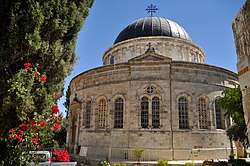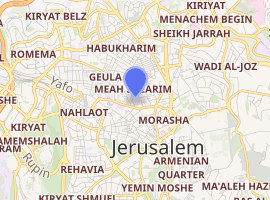Kidane Mehret Church, Jerusalem
The Kidane Mehret Church[1] (Ge'ez for "Covenant of Mercy")[2] in Jerusalem is part of the Debre Genet (ደብረ ገነት)[3] monastery, whose name means "Monastery of Paradise".[4][5]
| Kidane Mehret Church | |
|---|---|
 | |

| |
| Location | Jerusalem |
| Country | |
| Denomination | Ethiopian Orthodox Church |
| Architecture | |
| Groundbreaking | 1888 (?) |
| Completed | 1893 |
| Specifications | |
| Height | c. 30 metres |
The monastery and its church belong to the Ethiopian Orthodox Tewahedo Church. It is one of two Ethiopian monasteries in Jerusalem, the other one being Deir es-Sultan, which is part of the Church of the Holy Sepulchre complex.[5]
Etymology

Kidane Mehret (ኪዳነ ምሕረት) is a Ge'ez phrase meaning Covenant of Mercy. It refers to the Ethiopic tradition that Jesus promised his mother that he would forgive the sins of those who sought her intercession.[2][6][7]
The feast of Our Lady of the Covenant of Mercy is celebrated on 16 Yekatit (Ethiopian calendar), corresponding at present to 24 February (Gregorian calendar)[8] except in leap years, when it corresponds to 25 February, since in the Ethiopian calendar the extra day is inserted in what for the Gregorian calendar is the preceding month of September.
History
Emperor of Ethiopia Yohannes IV (r. 1872-1889) used war booty won in his conflict with the Khedivate of Egypt to purchase land to the south of the Old City of Jerusalem in 1888. The next year Yohannes died in battle and was followed by Emperor Menelik II (r. 1889-1913). The church was inaugurated in 1893.[4][5][9][10]
Description

The Kidane Mehret Church in Jerusalem is round in shape with a dome of some 30 metres in height.
As in most Ethiopian churches, the interior consists of three concentric rings. In the centre is the square meqdes (መቅደስ), "sanctuary", also called the qiddiste qiddusan (ቅድስተ ቅዱሳን), "holy of holies", which only priests and deacons may enter and which contains the tabot, the tablet over which the Eucharist is celebrated. Around this is the circular part known as qiddist (ቅድስት), "holy", intended for those able to receive holy communion. The outer circular ring, the qne mahlet (ቅኔ ማሕሌት) is for the cantors and is accessible by the faithful generally.[11][12][13][14]
Another Ethiopian monastery in Jerusalem

The Debre Genet monastery is not the only one in Jerusalem with Ethiopian monks. On the roof of the Chapel of Saint Helena of the Church of the Holy Sepulchre, Ethiopian monks have possession since 1850 of the rudimentary monastery called Deir es-Sultan and of two associated chapels since 1970. Ownership is a subject of dispute between the Ethiopian Orthodox Tewahedo Church and the Coptic Orthodox Church of Alexandria.[4][15][16]
See also
- Ethiopian Orthodox Church
- Oriental Orthodoxy
References
- The name of the church, ኪዳነ ምሕረት, is transliterated in various ways, such as Kidane Mihret, Kidane Meheret, Kidane Mahret.
- "Ethiopian Orthodox Tewahedo Church Sunday School Department, "The Covenant of St. Mary (Kidane Mihret)"". Archived from the original on 2017-02-02. Retrieved 2017-02-17.
- Transliterated also as Debre Gennet and Debre Gannet
- Robin Twite, "Africa in Jerusalem - The Ethiopian Church" in The Israel Review of Arts and Letters, 1996/102
- "The Ethiopian Church in Jerusalem - Debre Genet (Sanctuary of Paradise)". anglo-ethiopian.org. Retrieved 2016-12-11.
- The Art Institute of Chicago, "Miracles of Mary (Te'amire Maryam)"
- Covenant of Mercy, Ethiopia and Eritrea
- The Ethiopian Orthodox Tewahedo Church Faith and Order, "Religious Holidays and Calendar"
- Obioma, Ofoego; Alaba, Onajin (2015-10-05). Taytu Betul: the rise of an Itege. UNESCO Publishing. ISBN 9789231001048.
- David Rapp, Churches and Monasteries in Jerusalem (Hanan Isachar Photography 2016 ISBN 978-965700007-6), p. 66
- Sergew Hable Sellassie, Belaynesh Mikael, "Worship in the Ethiopian Orthodox Church"
- Getnet Tamene, "Features of the Ethiopian Orthodox Church and the Clergy" en Asian and African Studies 7 (1998), 1, p. 94
- "Places of Worship". Archived from the original on 2016-05-21. Retrieved 2017-02-17.
- Kiros Gebru, "The Cosmological Symbolism of the Ethiopian Church Building"
- Davies, "Unholy row threatens Holy Sepulchre" (BBC)
- Jonathan Lis, "Monastery Atop Church of Holy Sepulchre in Danger of Collapse" (HaAretz)